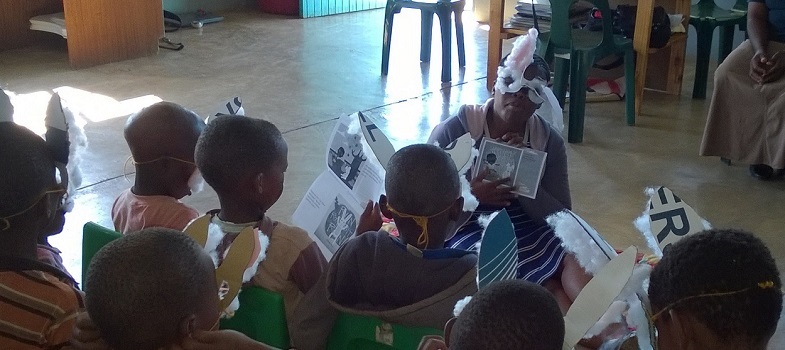Developing comprehension and thinking skills through questioning
Young children need the security and memory-building that comes from repeated activities, stories, games and songs – all of which support the development of early literacy skills.
But they also need their minds to be constantly challenged. When children are learning to read, asking questions helps them to make meaning or comprehend what’s been read.
The purpose of reading is to understand what’s been read. Young children do this by listening to the teacher read and joining in with familiar words and phrases. They can then answer questions about what’s happened or what they think might happen next, such as ‘Who knocked on the farmer’s door?’ or ‘What animal do you think has eaten all the maize?’. As children learn to read independently, they can ask and answer each other’s questions, as well as answering the teacher’s.
Even very young children can benefit from being asked questions in every lesson, and there are lots of ways of doing this. You can ask questions that encourage young children to think and talk about their lives and ideas. You can also ask questions after you have told or read a story – asking questions encourages children to develop their comprehension skills, a key skill for reading.
Comprehension questions can mainly be divided into two types: closed and open-ended.
Closed questions
Closed questions can test children’s knowledge, memory or understanding of what’s been read. Examples include:
- How many legs does the rat have? (Answer: four)
- What was the name of the main character in the story? (Answer: Bongani)
Closed questions are useful because they:
- have just one answer or a small number of possible answers
- develop children’s confidence that they may know the correct answer
- can indicate to the teacher how much each child understands – this is especially important when children move from learning in their home language to learning in English
- can sometimes show a teacher what a child doesn’t know, so a teacher can plan to do extra teaching
- can be asked to individuals, pairs or groups, or for a whole class to chorus the answer.
Open questions
Open questions encourage thinking, imaginative and reasoning skills. Examples include:
- What would it be like to be the frog in the story? (Possible answers: I would have to hop to school! I wouldn’t need any shoes! I could jump over the school gate.)
- What do you think Bongani is doing in this picture?
Open questions are useful because they:
- have many possible answers
- allow children to be imaginative with their answers and use their personal or cultural knowledge to answer
- encourage a wide use of vocabulary
- encourage children to give reasons for their answers ( using the word ‘because’) and think about causes and effects
- ask children to return to what they’ve read to provide reasons for their answers
- can be a challenge to very able children
- are a good opportunity for children to work together in pairs or small groups to think of their answers.
Activity 3.1: Thinking about questions
The table below shows some closed and open questions that a teacher might ask young children in a reading lesson. Notice the different ways that closed and open questions are phrased, and how the open questions lead to longer answers. These types of questions give children an opportunity to think more deeply.
In your study notebook, fill in possible answers to each open question (that a 5–6-year-old might give). Then add a question and answer of your own.
| Closed questions | Open questions |
|---|---|
| Is that a lion or a cat? | What’s the difference between a lion and a cat? |
| Answer: It’s a cat | Possible answers: A lion is a dangerous animal and a cat is not. A lion is a bigger type of cat. I like cats but I don’t like lions. |
| Is it raining? | How do you know it is raining? |
| Answer: Yes, it’s raining. | |
| What is the boy in the picture doing? | What do you think will happen next? |
| Answer: He is running to school. | |
| Where is the girl hiding? | Why is the girl hiding? |
| Answer: She is hiding behind a tree. | |
Introduction



